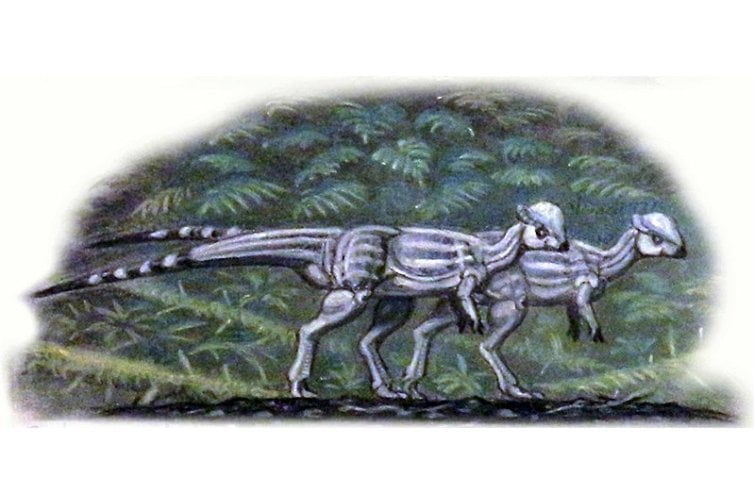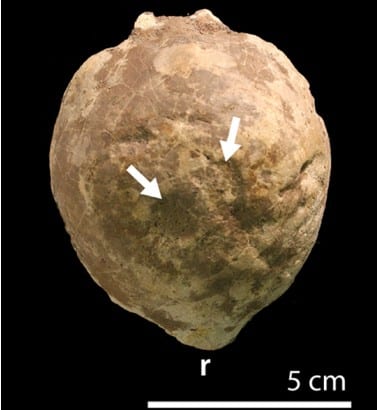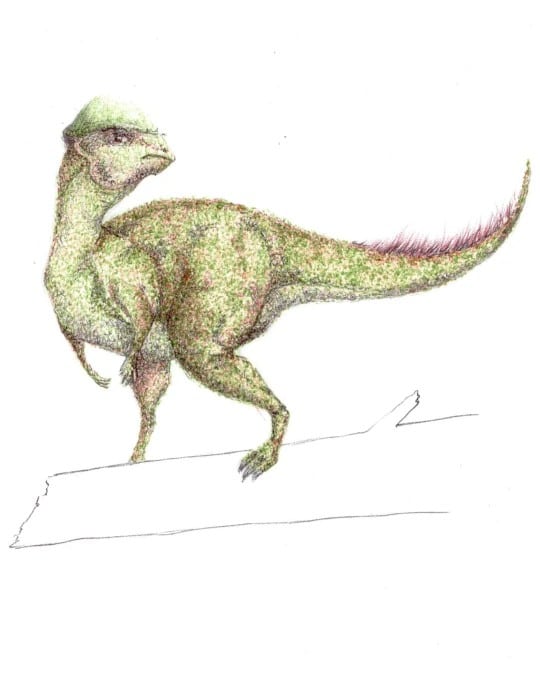Imagine journeying back in time to an era when dinosaurs roamed the earth. Among these prehistoric giants, there was one that stood out due to its unique head shape–the Sphaerotholus. This dinosaur, whose name means “Ball Dome Head,” belonged to the Pachycephalosauridae family which were known for their distinctive dome-shaped skulls. This dinosaur in particular was an herbivore that lived during the Late Cretaceous period.
Sphaerotholus Key Facts
| Keyword | Fact |
|---|---|
| Sphaerotholus pronunciation | sphe-ro-tho-las |
| Meaning of name | Ball Dome Head |
| Group | Pachycephalosaurs |
| Type Species | Sphaerotholus goodwini |
| Diet | Herbivore |
| When it Lived | 72.1 to 66.0 MYA |
| Period | Late Cretaceous |
| Epoch | Maastrichtian to Late/Upper Maastrichtian |
| Length | 6.6 ft |
| Height | 2.6 ft |
| Weight | 0.04 tons |
| Mobility | Moved on two legs |
| First Discovery | 2002 by Williamson and Carr |
| Location of first find | Kirtland Formation (Dena-zin Member) in the San Juan Basin in New Mexico |
| First Described | 2002 by Williamson and Carr |
| Holotype | NMMNH P-27403 |
Sphaerotholus Origins, Taxonomy, and Timeline

The name Sphaerotholus is derived from the Greek words ‘sphaira’ meaning ‘ball’ and ‘tholos’ meaning ‘dome’. This perfectly encapsulates the unique head shape of this dinosaur. It belongs to the Pachycephalosauridse family. This group of dinosaurs is known for their distinctive dome-shaped skulls. The type species of this genus is Sphaerotholus goodwini and was named in honor of paleontologist Mark Goodwin for his significant contributions to the study of pachycephalosaurid dinosaurs.
This herbivore lived during the Late Cretaceous period, specifically the Maastrichtian epoch. This was a time when dinosaurs were the dominant terrestrial vertebrates and the earth was warm and teeming with life.
Discovery & Fossil Evidence
This dinosaur was first discovered in 2002 by Williamson and Carr in the Kirtland Formation in the San Juan Basin in New Mexico. The holotype, NMMNH P-27403, is an incomplete skull lacking the facial and palatal elements. This discovery was significant as it added a new genus to the Pachycephalosauridae family.

Subsequent finds have been made in Alberta and Saskatchewan in Canada as well as Montana in the USA. These finds have expanded our understanding of the Sphaerotholus’s distribution and provided valuable insights into the dinosaur’s physical characteristics and its environment.
Sphaerotholus Size and Description
This is a fascinating dinosaur not just because of its unique head shape, but also due to its characteristics and its place in the Late Cretaceous period. Let’s take a closer look at what makes this dinosaur special.
Short Description of Sphaerotholus
With its distinctive dome-shaped head, this dinosaur was a sight to behold. This unique feature is what gives it its name, translating to “Ball Dome Head” from Greek. The dome shape of its skull is a characteristic feature of the Pachycephalosauridae family to which it belongs. It was an herbivore, feeding on the lush vegetation of the Late Cretaceous period.
Size and Weight of Type Species
Researchers have not well documented the size and weight due to the scarcity of available fossils. However, by comparing the size of the skull with other members of the Pachycephalosauridae family, they infer that this dinosaur was of medium size. They can only make more precise estimates of its size and weight upon discovering more complete fossils.
The Dinosaur in Detail

The Sphaerotholus is a fascinating dinosaur, not just because of its unique head shape but also due to its characteristics and its place in the Late Cretaceous period. Its dome-shaped skull, a characteristic feature of the Pachycephalosauridae family, is what gives it its name. This unique feature sets it apart from other dinosaurs and is a testament to the diverse forms that dinosaurs took during their reign on earth.
It was an herbivore that fed on the lush vegetation of the Late Cretaceous period. Its diet would have consisted of a variety of plants, including ferns, cycads, and conifers. The shape of its teeth and jaw suggests that it was well adapted to chewing tough plant material. Whether it moved on two or four legs is still a subject of ongoing research.
The Sphaerotholus is also notable for its wide distribution and long duration. Fossils of this dinosaur have been found in various locations across North America, including New Mexico, Montana, Alberta, and Saskatchewan. This wide distribution suggests that it was a successful species that was able to adapt to different environments and survive over a long period of time.
The Sphaerotholus in its Natural Habitat
The Sphaerotholus lived during the Late Cretaceous period, a time when the earth was warm and teeming with life. It inhabited regions that are now known as New Mexico, Montana, Alberta, and Saskatchewan. These regions would have been lush with vegetation, providing ample food for this herbivorous dinosaur.
The Sphaerotholus would have been a distinctive presence in these environments. Its diet would have consisted of a variety of plants, including ferns, cycads, and conifers. The shape of its teeth and jaw suggests that it was well adapted to chewing tough plant material.
This was likely a solitary dinosaur although this is still a subject of ongoing research. Its dome-shaped head could have been used for both display and combat. Due to the low number of fossils that have been found, little is known about its senses, such as sight, hearing, and smell. However, like other dinosaurs, it would have relied on these senses for survival, for finding food and avoiding predators. These adaptations made this dinosaur a true survivor of the Late Cretaceous period.
Interesting Points about Sphaerotholus
- It is known for its distinctive dome-shaped head. A feature that sets it apart from most other dinosaurs.
- It was an herbivore, feeding on a variety of plants during the Late Cretaceous period.
- It was a successful species that was able to survive over a long period of time and adapt to different environments.
- This dinosaur is a member of the Pachycephalosauridae family, known for their unique dome-shaped skulls.
Contemporary Dinosaurs
In the vast expanse of prehistoric time, this creature of unique disposition shared its world with an intriguing array of contemporaries. These dinosaurs included the Edmontosaurus, Tyrannosaurus, Triceratops, and Ankylosaurus.
Consider the Edmontosaurus, a herbivore of considerable size. Its existence alongside the Sphaerotholus paints a picture of a landscape abundant in plant life that was capable of sustaining creatures of diverse sizes and appetites. Despite its larger stature, the Edmontosaurus was not a threat to our main dinosaur but rather an example of the richness of their shared environment.
Then there was the Tyrannosaurus, a predator whose name still evokes awe and fear. Its presence suggests a potential danger to the Sphaerotholus, a thrilling element of risk in the daily life of our main dinosaur. Yet, the smaller and nimbler Sphaerotholus may have used its size to its advantage in order to evade the mighty jaws of the Tyrannosaurus.
The Triceratops and Ankylosaurus were both herbivores like the Sphaerotholus that add further depth to this prehistoric scene. The horns and frill of the Triceratops and the armored Ankylosaurus present a stark contrast to the smaller, less physically imposing Sphaerotholus. Yet, they all found a way to coexist, each playing their part in the intricate dance of life that unfolded in this bygone era.
List of All Dinosaurs
We have created a list of all dinosaurs we have covered here, sorted across the seven main groups of dinosaurs. We also include information about their type of diet, (omnivore, herbivore or carnivore) and the time they lived.
Frequently Asked Questions
The name means “Ball Dome Head”. It derives from the Greek words ‘sphaira’ meaning ‘ball’ and ‘tholos’ meaning ‘dome’.
It lived during the Late Cretaceous period, specifically the Maastrichtian epoch.
It was a herbivore, feeding on a variety of plants including ferns, cycads, and conifers.
Fossils have been found in various locations across North America. This includes New Mexico, Montana, Alberta, and Saskatchewan.
It was first discovered in 2002 by Williamson and Carr in the Kirtland Formation in the San Juan Basin in New Mexico.
Sources
- https://www.jstor.org/stable/4524278
- https://www.researchgate.net/publication/229992660_A_new_large_ornithomimid_from_the_Cretaceous_Dinosaur_Park_Formation_of_Alberta_Canada_Implications_for_the_study_of_dissociated_dinosaur_remains
- https://www.researchgate.net/publication/348819551_A_new_dromaeosaurid_Theropoda_Dromaeosauridae_from_the_Late_Cretaceous_of_New_Mexico
- https://academic.oup.com/zoolinnean/article/193/2/563/6125117
- https://www.sciencedirect.com/science/article/abs/pii/S0195667115300094
Article last fact checked:Joey Arboleda, 06-13-2023
Featured Image Credit: ABelov2014, CC BY-SA 3.0, via Wikimedia Commons
